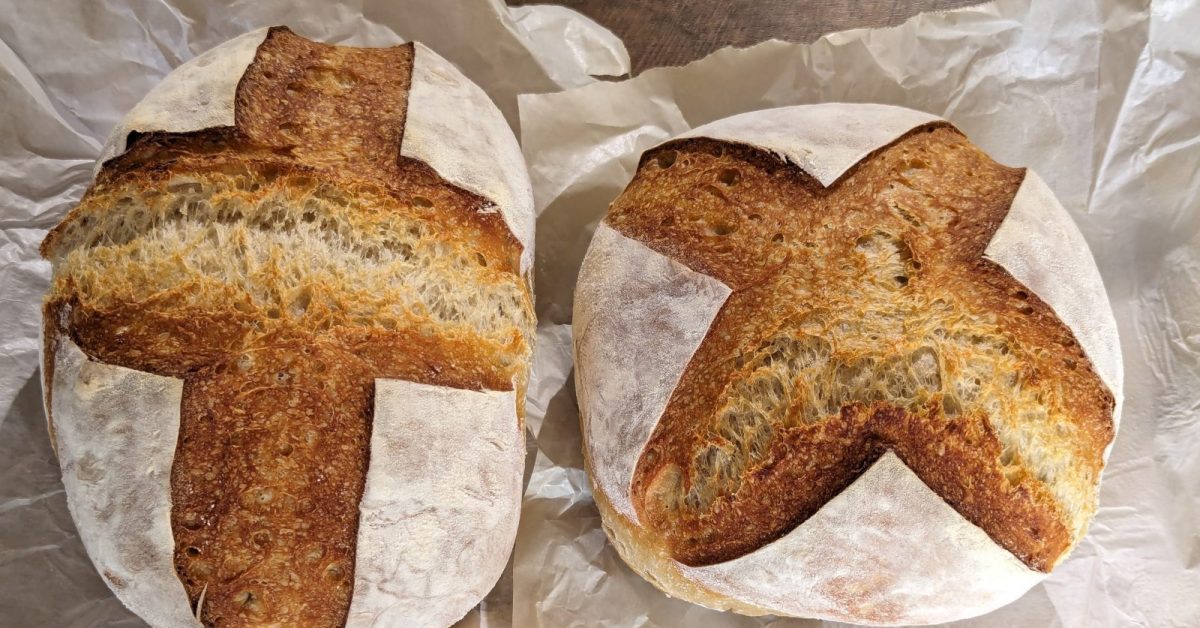
Disclosure: Your Homestead Gardener is a participant in the Amazon Services LLC Associates Program. I earn from qualifying purchases. This means that if you click on a link and make a purchase, I may earn a small commission at no extra cost to you. Thank you for supporting Your Homestead Gardener!
The Great Sourdough Journey – A Story for Beginners
I love a good slice of sourdough bread slathered with some rich, homemade butter. The hint of sourness, the fluffy insides, the crispy crust. My mouth is watering just writing this. However, my journey toward learning how to make the perfect sourdough bread loaf was anything but linear.
There are a lot of blogs and videos out there that teach you about sourdough breadmaking and baking, however, I am extremely stubborn and often impatient, and I simply don’t learn that way. I needed to learn by trial and error. I needed to dive in headfirst and hope for the best. So that is exactly what I did. This is my story on how I learned to make sourdough bread.
Sourdough Starter
A sourdough starter is necessary to make your loaves of bread. I never fully understood all the chemistry behind it – I just know that it’s a fermented dough that develops the yeast required to levy the dough for breadmaking. It took me several attempts and well over a month to fully understand and appreciate the various stages of my starter. I trashed several batches thinking I was doing something wrong. It didn’t look right, it didn’t smell right, it didn’t rise right. I’m telling you, nothing makes you feel more like a failure in life than starting your own sourdough starter lol.
It wasn’t until someone online shared a graphic with me that it all made sense. I’m sharing this graphic below, courtesy of The Sourdough Journey – a fantastic website that teaches you all about making sourdough. I am ever so grateful they made this graphic because it saved me so much time, struggle, and money lol. With this graphic, I suddenly had a better understanding of what was going on with my starter, and from that point on, I was successful. I just needed to take a step back and learn to trust the process.

The Ratio Game
The ratio game was the hardest part of it all. There is so much confusion on ‘The Right Way’. You’ll see the 1:1:1 ratio, the 1:2:1 ratio, the 1:2:2 ratio, and even the 1:3:3 ratio. It’s mind-numbing. Look, what works for me won’t necessarily work for you. Trial and error are the only way to learn here. This is why many people will post recipes and readers complain it didn’t work.
Most people like to work in grams, some like to work with cups. I’m so confident (now) in my starter and my ability to make bread that I just go off the look and feel of my starter. I don’t measure anything anymore. But it wasn’t always that way! I had tried measuring grams for my starter and it just didn’t work for me. Then I moved to using measuring cups, and that seemed to work better. Now I just eye it and it works out perfectly, every single time.
But for someone just starting out, you want to begin with a 1:1 initial mix. Then switch it up to a different ratio that works best for you. Focus less on the measurements and focus more on the consistency. You’re looking for a thick, gooey, sticky mixture. Here is a breakdown of what I did. I also wanted to note that I began my starter with ½ cup of flour, but that was broken into ¼ cup of whole wheat flour and ¼ cup of all-purpose white flour.
Making The Starter
Using 2 containers, alternate each day, scooping out ½ cup of starter (Day 2 onward) and adding it to a clean container with the water and flour. This is where they talk about sourdough discard. I simply tossed mine, others use it for baking. You do whatever you want with it. Back on point… here is what I did to create my strong starter:
Day 1: ½ cup flour and ½ cup water (1:1 ratio)
Day 2: ½ cup starter, ½ cup flour, ½ cup water (1:1:1 ratio)
Day 3: ½ cup starter, ½ cup flour, ½ cup water (1:1:1 ratio)
Day 4: ½ cup starter, ½ cup + 1 tbsp flour, ½ cup water (this is where ratios went out the window)
By day 4 – I was trying to make my starter really thick so I began to add a little more flour all while adding the same ½ cups of starter and water. This, for me, is where the real magic began.
Day 5: ½ cup starter, ½ cup + 2 tbsp flour, ½ cup water
Day 6: ½ cup starter, ½ cup + 2 tbsp flour, ½ cup water
Day 7: ½ cup starter, ½ cup + 2 tbsp flour, ½ cup water
By day 7 – I now had a beautiful starter that would reach peak activity within hours, and it smelled sweet and lovely. I was ready to make sourdough!
If your starter is doubling within 4-7 hours by day 7 then you too are ready to start using it. If you want a stronger starter you can continue to repeat the feeding process. If you’re simply not ready to bake with it, you can put it in the fridge until you are ready!
On To Making Sourdough Bread
Making sourdough bread was a whole new struggle and lesson to be learned because again, I can be rather impatient sometimes and I was just so excited to start baking. No one really tells you how long it takes to make one loaf or all the questions you’ll have along the way – and I think I know why now. It comes back to the simple fact that the process will be different for everyone. You have to find your own way!
Getting my timing right was now my biggest struggle. Making a loaf of bread is a 2-day process, and it took me a while to learn when to start my dough. I knew I wanted to bake my bread first thing in the morning – so I reverse-engineered the process:
I knew I wanted the bread in the oven by 6am so it was ready by 7am. I also knew that it had to sit in the fridge for a minimum of 6 hours, but preferably overnight (upwards of 48 hours, but I never go that long, overnight works just fine for me). So that would mean I wanted it in the fridge before I went to bed (9pm) giving my bread 9 hours to bulk ferment. Ok. Prior to it going in the fridge, I knew it had to sit on the counter to rise for 8-10 hours. So that puts me at 1pm(ish). I also knew I had 2 hours of stretches and folds to do after I initially mixed my dough (4 series of 4 stretches and 4 folds every 30 minutes) . So 11am. I also know my starter reaches peak activity within 4 hours of me feeding it. So that means I need to feed it no later than 7am.
I’m an early riser myself. I get up at 5am – I’ll take my starter out of the fridge, add ½ cup of water and enough flour to make it thick and sticky. I’m now 2 hours ahead of schedule, so this allows me the playroom necessary should I need extra time for bulk fermenting or other processes. Perfect!
What About The Left Over Starter?
So, you have your starter which should be a little more than ½ cup. You fed it, it doubled, you used half of it to make your bread, and now you still have roughly half a cup left. What do you do with it? I will feed it again (just a small amount, a tbsp of water and flour) then put it right into the fridge. It can stay there for weeks on end without needing a feeding. Once you’re ready to bake again, just remove it from the fridge, add ½ cup of water and flour (add more flour than water), and watch it come alive again! Within 4 hours she’ll be ready to use to make bread.
The goal is to try and keep at least a ½ cup of starter in the fridge at all times (or more if you make a lot of loaves at a time, but we only make 1 or 2 loaves a week so this works well for us).
Breaking Bread
So now you’re following a recipe to make the bread. The recipe I use specifically, can be found here. However, this is also where I do things a little differently. After she’s proofed for 8-10 hours on the counter, now I shape it, put it in the container it will bake in, and load it up with flour on all sides. I cover it with a dry cloth and let it sit in the fridge overnight. This may be considered sacrilege to some, but it’s what works for me.
I find doing this really helped with hardening the crust a little which made for better scoring. So, once she is done with bulk fermentation in the fridge, I score it right away, then let it rest on the counter for 30 minutes.
On to my next struggle… I don’t have a Dutch oven for baking my bread. I began by simply placing the dough in stoneware and covering it with aluminum foil. That kind of worked, but not well. Then one day I had an epiphany – we have an oversized roasting pan with a lid that allows me to fit 2 of my bakeware in it. So, I gave that a shot, and low and behold, it made the perfect loaves with the perfect crust! So, this is now my way of making the perfect sourdough bread. The lesson here: Work with what you’ve got and don’t be afraid to experiment.
In The End
I guess, in the end, I really wanted to share my story so that you can understand that making sourdough is not as simple as just following a recipe. It’s really a life lesson on persistence, perseverance, learning how to do things your own way, and how not to follow the crowd. It’s a lesson in patience and a lesson in how what works for me won’t work for you. I used to think gardening was the perfect life coach, as you learn A LOT of life lessons when learning to garden. But I’ll be damned, wouldn’t you know it – making sourdough has taught me an awful lot as well.
The biggest lessons were: Don’t give up. Don’t listen to everyone on the internet. Learn the basics then find your own way through experimentation. What works for me won’t necessarily work for you. Don’t overcomplicate it. And you don’t need all the fancy tools and equipment to make this work. Start where you are, and work with what you have. TAKE NOTES of everything you do when experimenting! Be patient, and lastly, have fun with it.
Please reach out if you have any questions! Take care and happy baking!

The Only Garden Journal You'll Ever Need!
Embark on a journey through the seasons with ‘Blooms and Reflections‘ your companion in cultivating the garden of your dreams. This beautifully crafted gardening journal unfolds over 91 pages, offering a comprehensive space for all your gardening aspirations and practical needs.




